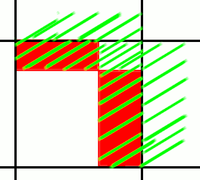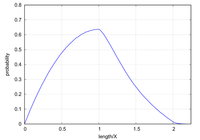Tee Zad Awk
New member
- Joined
- Feb 6, 2020
- Messages
- 4
Hello,
I'm looking at a problem that I am stuck on.
This is the question:
There is a checkerboard grid of infinite length. There is also a random line segment P of length D What length of D maximizes the probability that this line segment P will cross exactly one line on the checkerboard grid? Additionally, what is this max probability?
Here is my attempt at this question (pasted below): https://math.stackexchange.com/ques...-line-segment-crosses-only-one-line-in-a-grid
/////////////////////////////////////////////////////////////////// Paste Begins ///////////////////////////////////////////////////////////////////
Let's assume we have a grid of squares that stretches into infinite. Each square has a side length of X. I've drawn the grid below. I want to know if what I've written below is the correct way to find the maximum probability that line segment P crosses at least one grid-line on this grid.
As an example, the grid below is 4 by 4, in reality the grid stretching on for infinity in all directions.
Grid

Lets look at the extremes. We know a dot in this grid will never cross one line. Alternatively, we know that a line segment Y equal to √((2X)2+X2) or X√5 will always cross two squares in the grid. See below:

Hence our answer for P needs to be somewhere in between these two lengths (0 and X√5). The chance a line segment P crosses a single grid-line is maximized when D is X√5/2 (the midpoint of line Y), as shown below. I came to this conclusion because the probability of crossing a single grid-line for all lengths of D on Y is normally distributed (starts at 0 for a single dot, and heads back to 0 when D=Y).
Midpoint Line Length (D)

I'm struggling on calculating the probability that this line crosses at least one grid-line. This is my current reasoning:
We know that a line (Z) of length √(X2+X2) will always cross at least one line. See below:

Hence, the probability of our maximum probability line segment P is represented by the area of a circle (CircleP) where D is the radius, divided by the area of a circle (CircleZ) where Z is the radius. Conceptually Z represents a line long enough for a 100% chance of crossing exactly one line. So by doing CircleP/CircleZ we are finding the probability that P will cross at least one grid-line.
Maximum probability that line segment P crosses at least one grid-line = πP2/πZ2
/////////////////////////////////////////////////////////////////// Paste Ends ///////////////////////////////////////////////////////////////////
Someone has referred me to the Buffon Needle problem, which is similar but not exact.
I've also spoken to a friend who solved this and he told me my answer is wrong. Hence, I'm here
I'm looking at a problem that I am stuck on.
This is the question:
There is a checkerboard grid of infinite length. There is also a random line segment P of length D What length of D maximizes the probability that this line segment P will cross exactly one line on the checkerboard grid? Additionally, what is this max probability?
Here is my attempt at this question (pasted below): https://math.stackexchange.com/ques...-line-segment-crosses-only-one-line-in-a-grid
/////////////////////////////////////////////////////////////////// Paste Begins ///////////////////////////////////////////////////////////////////
Let's assume we have a grid of squares that stretches into infinite. Each square has a side length of X. I've drawn the grid below. I want to know if what I've written below is the correct way to find the maximum probability that line segment P crosses at least one grid-line on this grid.
As an example, the grid below is 4 by 4, in reality the grid stretching on for infinity in all directions.
Grid

Lets look at the extremes. We know a dot in this grid will never cross one line. Alternatively, we know that a line segment Y equal to √((2X)2+X2) or X√5 will always cross two squares in the grid. See below:

Hence our answer for P needs to be somewhere in between these two lengths (0 and X√5). The chance a line segment P crosses a single grid-line is maximized when D is X√5/2 (the midpoint of line Y), as shown below. I came to this conclusion because the probability of crossing a single grid-line for all lengths of D on Y is normally distributed (starts at 0 for a single dot, and heads back to 0 when D=Y).
Midpoint Line Length (D)

I'm struggling on calculating the probability that this line crosses at least one grid-line. This is my current reasoning:
We know that a line (Z) of length √(X2+X2) will always cross at least one line. See below:

Hence, the probability of our maximum probability line segment P is represented by the area of a circle (CircleP) where D is the radius, divided by the area of a circle (CircleZ) where Z is the radius. Conceptually Z represents a line long enough for a 100% chance of crossing exactly one line. So by doing CircleP/CircleZ we are finding the probability that P will cross at least one grid-line.
Maximum probability that line segment P crosses at least one grid-line = πP2/πZ2
/////////////////////////////////////////////////////////////////// Paste Ends ///////////////////////////////////////////////////////////////////
Someone has referred me to the Buffon Needle problem, which is similar but not exact.
I've also spoken to a friend who solved this and he told me my answer is wrong. Hence, I'm here


